Cartoons, roots & public service.
Of avian unity, fabric roots & social messaging.
Greetings, and thanks for welcoming me and my brew into your inbox.
This week I find myself wading through mid-century animation from India. Generations grew up gently fed on nation-building themes addressed with early animation techniques, odd humour and a simplicity that lasts. I sat amused, amazed, charmed and befuddled with many of these. You might too.
There is also a striking Nike collaboration worth peeking at, and a heartfelt non-apology from Channel 4 in the UK.
One, Many & More: Socially uplifting 20th century animation.
Tie-dye collaborations: Nike, meet Bandhani.
Friday Find: Sorry, Not Sorry!
With: Underage influencers, Kohli’s summer that isn’t, tomato trends, obnoxious spies.
1. One, Many & More.
What we watch, read, listen as children can often have disproportionate impacts on how we feel, think and see the world. In a time when we (young and not so young alike) are inundated with content, I found myself recently thinking of some creaky visuals and audio from my childhood. These will likely resonate with most desi (Indian) readers, with dollops of both nostalgia and messaging- but should also offer a curious peek for those from other lands.
Avian unity is what first comes to mind. Ek Anek aur Ekta (One, Many and Unity) is an animated film from just over fifty years ago, more often remembered as Ek Chidiya, Anek Chidiya (One Bird, Many Birds). I can say with some certainty and little science, it is the most vividly recalled short film for multiple generations of Indians, from the 70s through to even the early 90s, when cable television finally landed its jumbo jet on those shores.
“I still wish, things could be that simple and relatable in today’s world. Today, it seems we are living somebody else’s dream,” _Chander Verma, author & academician.
It was one of a (long) era of animated shorts that the Films Division of India (FDI) created. Across the decades, the format was chosen to seed and share positive messaging for a young nation, though not only for the young in the nation.
Established in 1948, the FDI was a central government body tasked with producing documentaries, newsreels and short films for public consumption. In the age Disney was shining, the Films Division set up its Cartoon Film Unit in 1956. In fact, Disney animator Clair Weeks- who worked on Bambi and Snow White- assisted in setting it up.
Here, the aim was not to create fantastical worlds for pure entertainment. This was post-independence India, with a growing grasp on the potential of cinema for public information, education, and ‘national integration’. The core purpose of these animated shorts was social upliftment and nation-building. The animators were artisans serving a national cause.
It was not just telling stories about cats and dogs and creatures chasing each other or gags. This was communication with purpose. _Ram Mohan
Take, for instance, one of the more memorable films- Tree Of Unity from 1972. With no dialogue or text, in less than four minutes, it manages to touch on nature, unity and cooperation. There are bits that amuse (intentionally or otherwise!), but they only add to the charm- indeed, leaving nuggets for nostalgia too.
“Homegrown tomatoes are good for the palate, and for the purse too!”
Wives & Wives attempted to combine droll humour and some sci-fi aesthetics (wait, what!?) into a social awareness spot in the 60s. It has full ‘Jetsons’ vibes, having launched in the same year as the iconic American cartoon show. What commentary it looks to make on gender roles and the notion of marriage, I leave to you to judge-though take your 1960s Indian context with you!
Baap Re Baap promotes family planning, another wordless but sprawling piece that crafts the contrast between the chaos of a family of six and the gentle loving life led by a family of four. (Aside- are these are the myths we grew up on- thinking raising two kids is peaceful ha!?). On another note, the use of multiple frames within the frame, and different aspect ratios is wonderful, all the more so from 56 years ago.
And so to Ek Anek aur Ekta from 1974, the only one of these in Hindi (I searched for a version with English subtitles for the iconic lyrics, but no luck). An elder sibling explains the idea of unity to her young brother, and then to a horde of clamouring kids. Starting with examples she then moves into song, with the fable of a flock of birds escaping a hunter. The film and song chirpily traverse across birds, flowers, stars, squirrels, the sun, the moon and people, to lay out the message of unity in diversity. Indeed, this was one of the most fundamental values I recall learning about across many years of childhood.
“To me, it appeared that the most strong point of India has been to live with diversity and profit from it. I wanted to communicate this to children and relate it to their own experience. So I wrote a script that children would understand and enjoy” _Vijaya Mulay
The film was directed by Vijaya Mulay and Bhimsen, who did the design and animation; Mulay, of course, had a renowned life as filmmaker, film historian, researcher and educationist. The lyrics were in some way, the most memorable part- going from a simple refrain to a full blown song on Indian diversity, “Hind Desh Ke Niwasi”, written by Pandit Vinay Chandra Maudgalya, set to music by Vasant Desai.
The singer- I did not know this- was six year old Sadhna Sargam, who went on to become a National Award winning singer in the Hindi film industry. The film itself won a National Film Award for Best Educational Film in India, and even the Best Children's Film award in Japan, underscoring a universal appeal.
There are many more, of course, and the FDI itself has many of them on their Youtube channel.
It was not great exciting work in terms of the story, but we did manage to bring in some humour, some characters that were typically Indian.
What I find interesting also- between budgetary and time constraints, and the state of the craft- techniques of ‘limited animation’ were often employed- reusing frames, simple movements. Today they seem basic, even crude in places. But this economical approach in its own way contributed to a distinct aesthetic. Clarity and message delivery became the focus; this often makes for a longer-lasting, meaningful piece.
While many were meant to connect with younger audiences, its only the odd moment that feels infantilising. Instead, it comes across as messaging unencumbered by complexities, given wings by humour, clarity and above all, simplicity.
These need, of course, to be taken in the context of the times. ‘National integration’, communal harmony, unity in diversity, family planning, economic progress… these buzz terms were very much the threads spun into a nation’s ideas of progress and prosperity. Many might argue these themes continue to hold weight.
Indeed, in 2012, Vijaya Mulay believed this to be true of her iconic creation. “I think it is (relevant). Our country is now facing difficult times, with people being led to hate and see others different from them as outsiders. We have to keep on reminding ourselves that diversity is our greatest strength, and unity in diversity is something that we have managed to follow, which is very important. And it has to be cherished.”
· ~ ·
Ram Mohan has been referred to as the Father of Indian animation- a veteran Indian animator, title designer and design educator, who spent 60 years in the field, starting with that training with Clair Weeks. As he recalled, “it was not just telling stories about cats and dogs and creatures chasing each other or gags. This was communication with purpose. There was a lot of skepticism and cynicism around even in those days whether these things are going to work at all, but it was interesting trying to work out the stories and trying to communicate this whole idea of development.”
Ram Mohan worked on The Banyan Deer (English) in 1957 with Weeks and other Disney animators (the feel of Bambi is apparent); and the above Baap Re Baap.
A look at Ram Mohan’s fine life & work. This included co-directing the Japanese produced Ramayana: The Legend of Prince Rama in 1992, and the Meena series with Unicef.
· ~ ·
· Remembering Ek Anek · A profile of Vijaya Mulay · Vijaya Mulay wrote on her journey, her thoughts on film, and India ·
▶️ Others for the playlist: · You Said It · A Great Problem · A Fable Retold ·
2. Tie-dye collaborations
I am not what you might call a fashion lover, neither in my personal sartorial adventures, nor in generic brand affinity. Yet, I find myself occasionally drawn to the creative and conceptual work done in fashion, beauty and luxury; usually when a brand owns a distinct view, embraces a creative punt or executes the normal in bold ways. In fact, I now realise I have featured a few over the last year- a limited edition fragrance brand that leans heavily into its creative and artistic soul; a ‘mainstream’ luxury brand that confidently plays with its ambassadors; another whose storytelling pulsates with a palpable passion.
All that is to say- another fashion visual caught my eye.
Nike’s collaborations with designers, artists and the creative world at large are not new. It would appear they have a first, though, with an Indian collective. Nor Black Nor White’s duo Mriga & Amrit were raised in Toronto; forays into their roots led to NBNW being established in a tiny home studio in Mumbai circa 2010, then moving to a new base in Delhi. They have since “naturally evolved into a cultural platform that mashes up explorations across (tex)style, stories, and special humans around the world.”
“To respect the past is to respect the process and the people who carry it forward.”
Mostly, though, its the aesthetic of the shoot that I like- striking use of location, poses and colours.
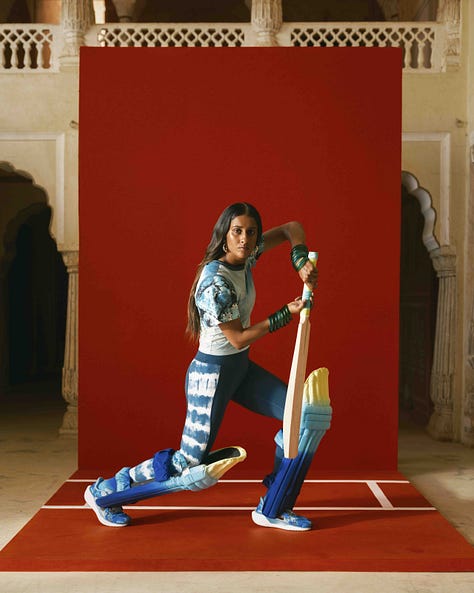
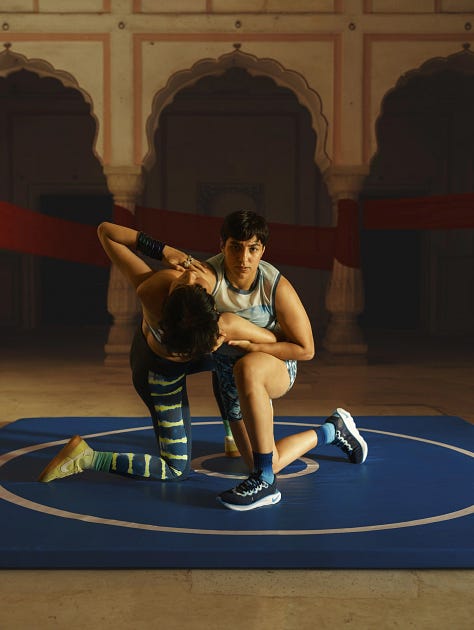

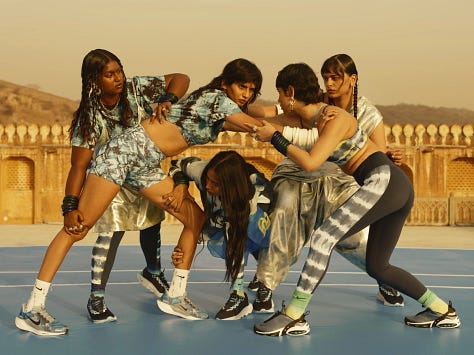

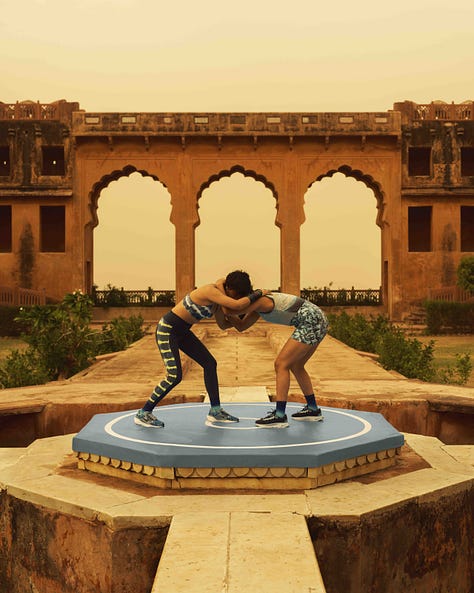
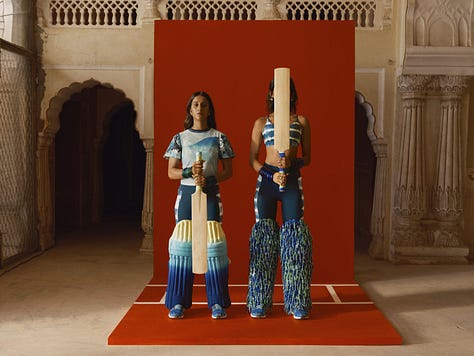
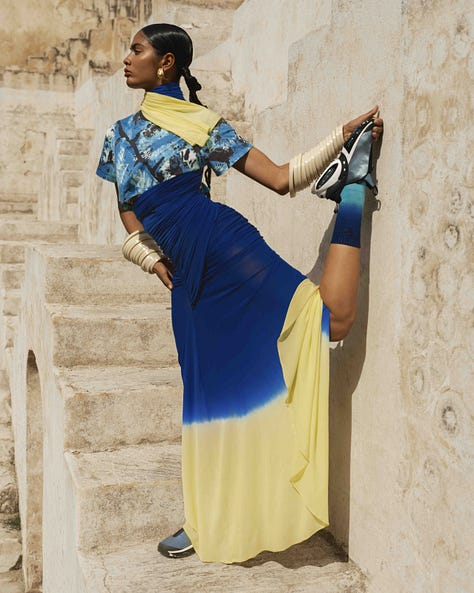
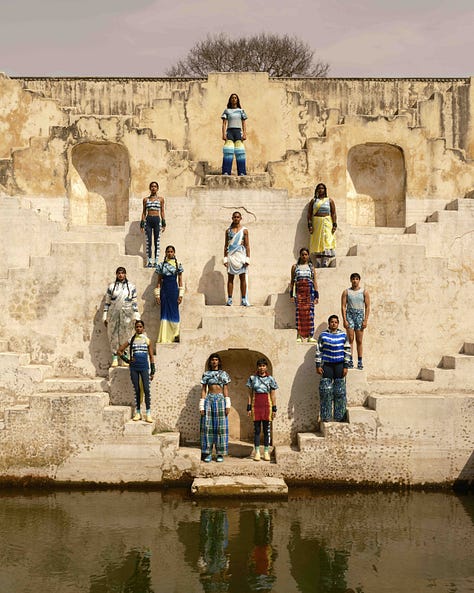
This collection invites women to sport with apparel, footwear and a cross-body bag meant to promote freedom of movement and expression. It also features bandhani (tie-dye), which has been a love for the NBNW duo since the early days.
Available globally, the duo hope to introduce “new communities to colors and patterns steeped in Indian culture”. The campaign features wrestler Anshu Malik, sprinter Priya Mohan and cricketers Jemimah Rodrigues and Shafali Verma.
Designed right here in India by a local collective that gets our vibe. Wearing Nike that’s laced with Indian culture is a flex. It’s bold, rooted, and ours. As a woman in a sport that’s often seen through a male lens, being part of a campaign like this is my way of saying, ‘We’re not just showing up, we’re here to take over, win big and look fab while doing it.’” — Jemimah Rodrigues, cricketer and Nike athlete
3. Friday Find: Sorry Not Sorry
Channel 4 in the UK is proudly Altogether Different with classically dry and sarcastic British humour in this latest spot.
Many organisations, brands and, dare I say, people, have gingerly or nimbly or gleefully- as may be their wont- stepped away from any previously championed values and love for diversity & inclusion. For some, the millstone formerly known as DEI. Indeed, ‘woke’ is indistinguishable from a pejorative term. (I rue the dilution and complete loss of value around the word, but that must remain a thought for another day).
In such times, I do enjoy a brand that owns what it is believes and does, doubling down on what it stands for- unapologetically.
So, “Ride Me To Narnia *****.”
Or something.
Masala Peanuts
“In times like these, when vitriol comes easier than virtue, this piece is not written in protest or praise. It is written in remembrance. For the game we once loved. And the way we were once taught to love it.” This wonderful piece in The Dawn is on Virat Kohli’s retirement, but manages to say much else.
Underage Influencers: “Young Brazilians chase social media fame, selling ‘get-rich’ schemes, while legal battles question platform responsibility and the cost to childhood.” Brazil is going after social media sites to keep its kids safe… while parents and ‘managers’ wax eloquent about how this is good for the kids, and their families.
Apparently in some parts of the world, the ‘scent of summer’ is... tomatoes. Ok then, penne arrabiata, here I come… I guess?
Add To Queue
-watchlist, playlist, readlist- :: stuff on my radar
Slow Horses on Apple TV+ with the absurdly captivating and obnoxious semi-discarded MI5 veteran Jackson Lamb, played by Gary Oldman, running a team of seemingly useless spies. Supremely equitable with his insults, he spews gems like, “I got haemorrhoids that are more f**king use than you”; and “I’ve got a full day of f**k-all to get through”, while remaining strangely, fiercely protective of his dysfunctional team. “I think they’re a bunch of absolute losers. But they’re my losers.”
“To respect the past is to respect the process and the people who carry it forward.” _NBNW










Interesting resd